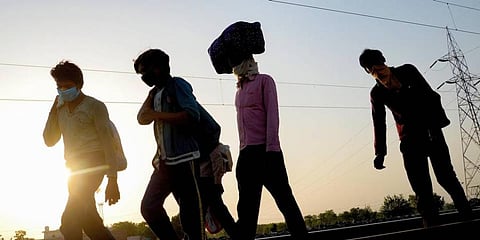In 8 years, migrant workers will equal one-sixth of Kerala’s population
THIRUVANANTHAPURAM: A recent projection by the state planning board says Kerala will be home to nearly 60 lakh migrant workers by 2030. Estimating that state’s native population will be 3.6 crore by that time, the migrant labour community in the state would equal one-sixth of the population.
A study on ‘In-migration, Informal Employment and Urbanisation in Kerala’, sponsored by State Planning Board (Evaluation Division) and released in August this year, has found that the state, which had an estimated 31.4 lakh migrants from other states during 2017-18, will have a migrant population between 45.7 lakh and 47.9 lakh by 2025 and 55.9 lakh and 59.7 lakh by 2030 as per the current rate of immigration. It indicates that the migrant workforce will outnumber the younger population in the villages across the state by 2030.
The recent violence at Kizhakkambalam triggered by migrant workers raises concerns whether Kerala would witness conflicts between immigrants and ethnic population which happen frequently in Assam.
According to experts, steps should be taken to integrate the migrant community into the local population as this would reduce the friction between them.
A study on ‘Demographic Changes in Kerala and the Emerging Challenges: An Assessment’, by the Centre for Socio-economic and Environmental Studies (CSES), has also found that the share of young workforce (20-34 years) has come down to 36.3% of the total working age population in the state in 2021 and the census-based projection indicates that it is expected to come down further to 33.2% by 2036.
‘Need to integrate migrants into local population’
The share was 50.3% of the total working age population in the state in 1991. Further, the state has been witnessing below-replacementlevel fertility over the past three decades. The state has been witnessing a sharp decline in total fertility rate (TFR) over the years. If the TFR was 4.1 children per woman in 1971, it has been in the range of 1.7-1.9 children per woman for over the last three decades in Kerala, whereas the TFR in India is 2.2 children per woman.
All these indicate that the state will have to face the prospects of migrants emerging as the dominant workforce and outnumbering the younger generation in the state in the coming decades. Benoy Peter, executive director, Centre for Migration and Inclusive Development, which works for the welfare of migrants, said, “It is true that Kerala is likely to face a situation in which migrants outnumber the local community in major pockets in the state.
There is also a chance for friction between the local community and migrants. But it doesn’t mean that an ethnic conflict as being witnessed in Assam would be repeated here. At the same time, we have to take steps to integrate the migrant community into the local population as this would reduce the friction between them.” George Mathew, coordinator of Progressive Workers’ Association, said, “In Assam, there are a lot of other factors which contributed to the escalating violence between ethnic Assamese and immigrants including political interests.
Here, such ethnic conflicts are unlikely considering the social behaviour of the state. At the same time, it is important to ensure the cultural integration of these two communities. A situation of not allowing the migrant community to integrate into the local community as happened at Kizhakkambalam cannot be entertained here,” he said.

